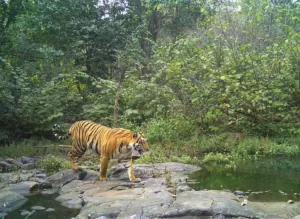Amrabad Tiger Reserve: A Hidden Jewel in Telangana’s Wilderness
Located in the Nallamala Hills of Telangana, Amrabad Tiger Reserve is one of India’s most picturesque and ecologically significant wildlife sanctuaries. Part of the Nallamala Forest Range, the reserve is known for its rich biodiversity, breathtaking landscapes, and a prominent tiger population. As the second-largest tiger reserve in India, Amrabad offers an incredible opportunity for wildlife enthusiasts and adventure seekers to experience nature in its purest form. Whether you’re hoping to spot elusive tigers, explore dense forests, or simply immerse yourself in the beauty of nature, Amrabad promises an unforgettable experience.
A Brief Overview of Amrabad Tiger Reserve
 Amrabad Tiger Reserve is located in the Mahabubnagar district of Telangana and spans an area of around 2,000 square kilometers. Established in 1989 as part of India’s Project Tiger initiative, the reserve is a crucial habitat for the Bengal tiger and numerous other wildlife species. Its diverse landscape, comprising dense forests, rocky terrain, and rivers like the Krishna River, makes it an extraordinary location for both wildlife conservation and eco-tourism.
Amrabad Tiger Reserve is located in the Mahabubnagar district of Telangana and spans an area of around 2,000 square kilometers. Established in 1989 as part of India’s Project Tiger initiative, the reserve is a crucial habitat for the Bengal tiger and numerous other wildlife species. Its diverse landscape, comprising dense forests, rocky terrain, and rivers like the Krishna River, makes it an extraordinary location for both wildlife conservation and eco-tourism.
The reserve’s natural beauty, combined with its conservation efforts, has made it an increasingly popular destination for nature lovers, photographers, and wildlife enthusiasts. A visit to Amrabad offers an opportunity to witness the delicate balance between flora, fauna, and habitat preservation.
Flora and Fauna of Amrabad Tiger Reserve
 Amrabad Tiger Reserve is home to a vast array of plant and animal species, making it one of the most biologically diverse reserves in southern India.
Amrabad Tiger Reserve is home to a vast array of plant and animal species, making it one of the most biologically diverse reserves in southern India.
-
Tigers: The reserve is part of the Project Tiger conservation effort, and it harbors a significant population of Bengal tigers. While tiger sightings are rare due to the reserve’s dense forest cover, the thrill of exploring their habitat makes it an exciting experience for visitors. Amrabad is one of the most critical tiger habitats in Telangana.
-
Other Mammals: Apart from tigers, the reserve supports a range of other big cats, such as leopards and wild cats, along with herbivores like sambar deer, chital (spotted deer), nilgai (blue bull), wild boar, and the Indian bison (gaur). The presence of these animals further enhances the ecological significance of the reserve.
-
Birdlife: Birdwatchers will find Amrabad an incredible spot, as it is home to a wide variety of bird species. Over 200 species of birds have been recorded in the reserve, including the Indian eagle-owl, crested serpent eagle, white-eyed buzzard, and various species of hornbills, pigeons, and kingfishers. The Krishna River and its surrounding water bodies also attract migratory birds, particularly during the winter months.
-
Flora: Amrabad is characterized by dry deciduous forests, primarily made up of sal, teak, bamboo, and acacia trees. The forest is rich in medicinal plants and shrubs, which have long been used by local tribes for traditional remedies.
Safari Experience at Amrabad
The best way to explore the Amrabad Tiger Reserve is through a jeep safari, which takes you through the reserve’s dense forests, rocky landscapes, and meandering rivers. The safaris offer a chance to spot tigers, leopards, and a host of other wildlife species while also observing the rich variety of flora that makes the reserve so unique.
-
Jeep Safaris: The reserve offers well-organized jeep safaris conducted by trained naturalists. These safaris are available in both the morning and afternoon and are ideal for wildlife sightings, particularly in areas near waterholes where animals tend to gather. The guides also share in-depth knowledge about the flora and fauna of the region, enhancing your understanding of the environment.
-
Trekking and Hiking: For those who love adventure, the reserve offers trekking and hiking routes through the Nallamala hills, providing an opportunity to explore hidden corners of the reserve. Although trekking routes are not as developed as safari trails, they offer a chance to experience the raw wilderness of Amrabad up close.
Best Time to Visit Amrabad Tiger Reserve
 The best time to visit Amrabad Tiger Reserve is during the winter months from November to March. The weather during this period is pleasant, and it’s easier to spot wildlife as animals congregate around water sources due to the cooler temperatures. The summer months (April to June) are also good for tiger sightings, but the heat can be intense.
The best time to visit Amrabad Tiger Reserve is during the winter months from November to March. The weather during this period is pleasant, and it’s easier to spot wildlife as animals congregate around water sources due to the cooler temperatures. The summer months (April to June) are also good for tiger sightings, but the heat can be intense.
The monsoon season (June to September) is not the ideal time to visit due to heavy rains that can make the terrain slippery and difficult to navigate.
How to Reach Amrabad Tiger Reserve
-
By Air: The nearest airport to Amrabad is in Hyderabad, about 150 kilometers away. From there, visitors can take a taxi or private vehicle to the reserve.
-
By Train: The nearest railway station is in Mahabubnagar, about 60 kilometers from Amrabad Tiger Reserve. It is well connected to Hyderabad and other major cities in Telangana.
-
By Road: Amrabad Tiger Reserve is well-connected by road, and visitors can take private taxis or buses from Hyderabad to reach the reserve. The journey by road offers a scenic drive through the countryside of Telangana.
Accommodation in Amrabad Tiger Reserve
Accommodation options near Amrabad Tiger Reserve are limited but cater to the needs of eco-tourists and wildlife enthusiasts. Visitors can choose from a range of eco-friendly lodges and forest guesthouses located near the reserve. For a more comfortable stay, there are hotels and resorts in Hyderabad or Mahabubnagar, which are a short drive away from the reserve.
Some tented camps and nature resorts located near the reserve offer a more immersive experience, allowing guests to stay closer to nature and participate in wildlife safaris and nature walks.
Conservation Efforts at Amrabad
Amrabad Tiger Reserve is an important site for the conservation of tigers and other endangered species. The reserve is part of India’s national efforts to preserve the Bengal tiger under the Project Tiger scheme. Efforts have been made to protect the reserve’s wildlife through anti-poaching initiatives, habitat restoration programs, and forest management practices. The involvement of local communities in conservation efforts has been crucial to maintaining the ecological balance of the area.
MUNNANUR JUNGLE RESORT, THE TIGER STAY PACKAGE
- Safari Ride at Farahabad
- Forest Trekking, which involves explaining about flora, fauna including special focus on birds.
- Tour guide
- Reside in cottages Six standard rooms, one Round Chenchu mud home, one tree house, two mud houses, and two Aercon houses make up the total of 12 rooms we have available.
- Depending on the style of hotel, the package for two people can cost anywhere between 4600 and 8000 rupees
Discounts for bulk booking
Booking amount Discount applicable
Greater than 20,000 but less than 40,000 5% of total booking amount
Greater than 40,000 10% of total booking amount
IMPORTANT NOTE
Time to Check In: 12:30 PM
Time to check out: 10:00 AM
IMPORTANT NOTE
Time to Check In: 12:30 PM
Time to check out: 10:00 AM
A Nature Guide must be hired, and their fee is Rs 100 per tourist, each activity. This fee must be paid to them immediately following the safari and the trek.
Food costs are not included in the Tiger Stay Package; nevertheless, they will be given based on order and menu availability.
** If there will be an odd number of guests, please reserve the next lower even number (for example, book 2 rooms for 5 guests).
Food will be charged individually on basis of order and available menu; children’s above 6 years of age reservation is required.
AT THE TIME OF CHECK-IN, Rs1000 shall be charged extra for any additional person from 8 years of age onward.
Address–
Mahbubnagar, Telangana 509201
Contact For More Information -:
Mob No -: +91 9154281766
Gmail -: artcircle@gmail.com
For More Updates About Other Tiger Reserve Please Visit -: https://yesnearme.com/news/
THANK YOU






Recent Comments